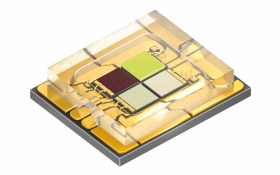Following the uprating of its headlamp LED last week, Osram has done the same with its stage lighting flagship.
Thanks to improved chip technology, its latest multi-coloured four-chip Ostar Stage family can be operated at 2.5A – 30W total input power, double that of the previous version.
“The higher current which is necessary for a higher output requires the thermal management of the Osram Ostar Stage to be adapted so that the heat generated in the chip can be removed as effectively as possible”, said Osram product marketing manager Wolfgang Schnabel.
The 1mm² die are red, green, blue and white.
With the beam characteristics and package size as before, existing user can retain their existing optics and the overall design.
Other intended applications are mood and architectural lighting.
High volume production is scheduled for Q1 next year.
Ostar Stage LE RTDUW S2WN at a glance
| Dimensions | 4.68 x 5.75 x 1.26mm |
| Chip size | 1mm² |
| Thermal resistance Rth | 0.9K/W |
| Output | 30W |
| Beam angle | 120° |
See also: Osram reveals best headlamp LED yet



